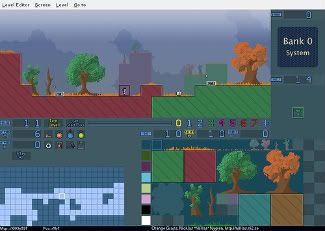
I have noticed some kind of trend emerging from my recent playings. Over the last few weeks, I have been working my way through The Lost Vikings, strangely obsessing over Out of this World (on which I will have more to say), dabbling with Blackthorne and Flashback, and juggling with Tomb Raider on the 3-D side of things ; all games that would arguably fit in the "required readings" of any aspiring level designer. Now, I have never seriously considered this profession for myself, and it might be too late to even start thinking about it. But seeing as prolonged exposure to a certain activity is almost guaranteed to spark a more pointed interest in the workings of said practice, I just might be having what we commonly call a "phase". I also felt that this sudden fascination with video game architecture had to be vented, and what better solution could there have been than to learn the ropes of a basic creation tool?
And so, a couple of days ago, I have created my first level using Knytt Stories' built-in editor. It is small, easy (I made it with my mother in mind), and I am fairly proud of it. "Hoo, wow, big man you are now", I hear you think. Well... maybe not, but it was nice to stretch some ideas that had been brewing for a while. Sketching a bare-bones skeleton before decorating more extensively, I had a great time measuring the jumps, thinking the atmosphere over, and especially constructing the level as a series of "gates" that would hopefully open in flowing, intuitive manner. The best part of the process, however, was to see other people of differing abilities try out the level, mostly progressing as intended, sometimes inspiring me to tweak a few tiles or shuffle a power-up. In the end, I got a basic idea of the elementary steps involved in game development, and I definitely intend to flesh out this little level.
But enough about me. Immediately after completing a satisfying build of my own, I started going through Auntie Pixelante's list of selected levels for Knytt Stories, which she designates as "recommended reading". I like the connotation implied by this title, because it stresses the fact that 2-D platforming truly is an artistic language of its own, albeit one that somewhat requires feats of dexterity, navigation and visual association for the communication to take place. If anything, the selected levels emphasize this idea of a common language: varied in pace, tone and difficulty, they all employ the resources offered by the editor in ways that feel distinctive, yet still of a piece with their fellow user creations. "A Walk at Night", for example, distills a clear and strong aesthetic arc over no more than a few dozens of easy panels, while the designer of "Flipping Out" thought it would be good to reinforce his vertigo-inducing core mechanic with a little extra challenge. Both evoke different types of engagement and levels of frustration while still sharing the same unmistakable basis, and I believe that is a testament to the creative flexibility of the Knytt Stories engine.
The irony of my relationship with this game is that I never even bothered to finish the included tales of Nifflas' own. Being such an admirer of the first Knytt, I always took it for granted that this follow-up couldn't have much more to offer, and that Stories' addition of power-ups was somewhat superfluous ; a treason of sorts towards the original's stripped-down perfection. I now realize that these collectibles allow for a more pronounced sense of progression, and that the game's subtle upgrades to the visual engine are for the better, but mostly I come to appreciate Knytt Stories as an exquisite foundation for greater things. What Nicklas Nygren has crafted is no more and no less than a toolset for beautiful things to emerge, with a certain air of lightness engraved in the physics themselves. Level crafting, then, becomes a way of confronting a user's vision with the inescapable core dynamic intended by the author of the software, and thus a collaboration towards a goal as yet unstated. I might come around to clearing "A Strange Dream" and "The Machine" someday, as they do seem to exemplify what makes Knytt Stories such a great achievement. For now, though, I come away from my brief tinkering with a better understanding of level design's main concern: to exert spatial variations on a preset tempo.
2d-games seem to be harder to fail with control-wise, something which games such as tomb raider need more tweaking with.
ReplyDeleteHow do you "deal with" backtracking in for example knytt? Is it a part of the progress laid out in the second game which requires power ups to advance to certain levels?
It's interesting that you mention backtracking, because it is something I consciously tried to implement in the level I describe. As you said, power-ups are an important part of the progress in Knytt Stories, and I constructed some sections in a way that specifically required the player to collect the item at the end of the corridor before being physically able of going back to the previous area. I think that, if executed fairly transparently (as a series of branches that culminate in a new section, for example), this can be a good way of managing backtracking, because it also acts as a testing ground for a new mechanic.
ReplyDeleteI am aware that the control schemes of 3-D games, being usually more faithful to real-world movement and physics, are much more subject to breaking down in the face of complex environments and activities. However, I also think that there are certain important similarities in the way that both formats handle spatial navigation and problem-solving, and I might discuss this in my next post.
Thank you for you comment : )